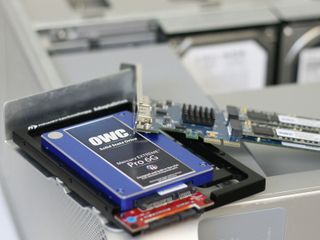When is fixing your Mac just throwing good money after bad?

This scenario replays almost every time I go to work at the local Apple retailer: A customer walks in with an older Mac that isn't working right. It happens sooner or later with just about any reasonably complicated device you own, whether it's your car, your washing machine, TV set, or even your Mac. So what's the answer?
It ultimately depends on a few factors — and price isn't the only thing to consider. How much faster will a new machine be? How have your needs changed since you first bought the Mac you're bringing in for repair? How much longer do you plan on keeping it anyway?
Labor
If your Mac is out of warranty, the first thing to know is that most places are going to charge you just to look at it. Our standard fee is $125.95 — it's a flat labor rate we charge regardless of how many hours the tech actually works on your device. That price will vary from business to business.
Parts
There's also the question of what needs to get fixed. If you've spilled a soda on the keyboard of your Mac laptop, for example, it can vary depending on the model and the severity of the damage. For some Macs it might mean replacing the entire "top case," which integrates the keyboard, trackpad and battery. The main logic board might have to be replaced, which is big money. Or perhaps just the MagSafe board needs to get pulled.
I see a lot of older Macs — five years, maybe older — come in with problems with their hard drives. Hard drives spin continuously when they're powered, and eventually those spindle motors and the read/write heads wear out. The good news is that hard drives are cheap to replace, and putting an SSD in place of a regular hard disk can often lead to dramatic performance improvements. The bad news is that if you don't have a backup, you may be facing lost data or a lengthy and expensive process of file recovery.
One common repair we have in the store is a screen replacement for a laptop. It's usually a younger user — college-aged or younger — and there's usually an accident or mishap to explain the damage: Leaving a heavy object on the computer, dropping it off a desk, falling asleep with it on the bed and having it crash to the floor. Screens are ridiculously costly for MacBooks — often almost half the price of the device. One way to cut that cost is to ship your laptop out to a mail-order repair service like iResQ. That's what I did when I needed to replace the screen on an '09 white MacBook. I saved hundreds and have been satisfied with the replacement screen.
Usability
There's a point of diminishing return when you fix a computer, as well, where you're simply not going to see any more performance or usability enhancements. Where fixing it may let you limp along for a while longer, but ultimately won't improve things. In those cases, it's almost always a good idea to retire your device.
Master your iPhone in minutes
iMore offers spot-on advice and guidance from our team of experts, with decades of Apple device experience to lean on. Learn more with iMore!
My general rule of thumb is that if the repair costs are going to equal or be greater than half the cost of buying a new computer, I'll try to talk the customer into replacing the computer instead. At that point you get a brand new computer that works fast and efficiently, and you get the added benefit of a full warranty.
Just remember that neither Apple's standard warranty nor AppleCare cover accidental damage, so think twice before you decide to take a nap with your MacBook Pro beside you, as one of my recent customers did.
Most Popular





